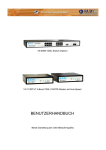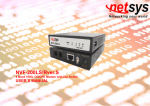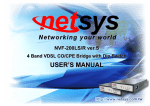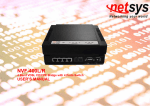Download MicroNet SP3501AM User`s manual
Transcript
User’s Manual VDSL CO / CPE Modem Model No.: SP3501AM/SP3501AS http://www.micronet.info Table of Contents Chapter 1 Introduction................................................................................. 1 1.1 Package Contents ............................................................................ 1 1.2 Key Features .................................................................................... 1 Chapter 2 Installation................................................................................... 3 2.1 Hardware Installation........................................................................ 3 2.2 Pre-installation Requirements .......................................................... 3 2.3 Cabling Requirements...................................................................... 3 2.4 Connecting the Modem .................................................................... 4 2.5 Connecting the RJ-11/RJ-45 Ports................................................... 4 Chapter 3 Physical Description .................................................................. 6 3.1 LED Definition .................................................................................. 6 3.2 Modem Rear Connectors ................................................................. 6 Chapter 4 Speed Configuration ................................................................. 7 4.1 Fixed/Auto Speed Function...............................................................7 4.2 Speed mode limitation...................................................................... 7 Chapter 5 Appendix ..................................................................................... 8 5.1 Cable Requirements......................................................................... 8 5.2 Specifications ................................................................................. 10 5.3 Troubleshooting.............................................................................. 11 5.4 Other Issues ................................................................................... 12 Chapter 1 Introduction Micronet SP3501AM / SP3501AS delivers cost-effective and highperformance broadband access to multiunit building environments, such as enterprise, campus, hospital, hotel, and telecom. With QAM-based 4-band VDSL technology, the VDSL solution dramatically extends Ethernet and supports 5M/15M/25Mbps symmetrical bandwidth over existing telephonegrade wiring up to 1.9/1.3/0.8KM. 1.1 Package Contents Prior to the installation of the device, please verify the following items are in the package: y y y y y y 1.2 y y y y y y y VDSL Modem ¾ SP3501AM VDSL CO Modem ¾ SP3501AS VDSL CPE Modem Quick Installation Guide Manual CD RJ-11 Cable RJ-45 Cable Power Adapter Key Features Compliant with ETSI, ITU, ANSI standards Compliant with IEEE802.3 10BASE-T and IEEE802.3u 100BASE-TX standards Support 1 x RJ-11 VDSL port and 1 x RJ-11 Telephone port Support 1 x RJ-45 Ethernet port of 10/100M QAM-based 4-band VDSL Data rate up to symmetrical bandwidth of 25Mbps Wiring range up to 1.9KM 1 y y Fixed/Auto speed function for VDSL link Built-in POTS/ISDN splitter (SP3501AM) for POTS/ISDN telephone service 2 Chapter 2 Installation 2.1 Hardware Installation This section describes how to install the Modem and establish network connections. Users may install the Modem on any level surface. However, please take note of the following minimum site requirements. 2.2 Pre-installation Requirements Prior to the start of actual hardware installation, make sure users can provide the right operating environment, including power requirements, sufficient physical space, and proximity to other network devices that are to be connected. Verify the following installation requirements: y y y 2.3 Power requirements: DC 5V/1A or above. The Modem should be located in a cool dry place with at least 10cm of space at the front and back for ventilation purpose. Place the Modem out of direct sunlight, and away from heat sources or areas with a high amount of electromagnetic interference. Cabling Requirements Before making any connections to the Modem, note the following rules: Connection Type Ethernet Port (RJ-45) Cable Requirements Maximum Length y 100 Mbps: Cat 5 UTP 100 meters max for MUX y 10 Mbps: Cat 3-4 UTP or HUB to endpoint. 3 y 24-26 Gauge phone wiring VDSL Port (RJ-11) y Do not recommend 28 or y 15M/15M: 1.3km y 25M/M: 800m above Gauge 2.4 y y y y 2.5 y 5M/5M: 1.9km Connecting the Modem The Modem provides a single Ethernet port, which support connection through Ethernet operation. Network devices attached to the Ethernet port must support autonegotiation, 10Base-T or 100Base-TX. Otherwise, the network device must always operate at half duplex. The RJ11 Line port is used to connect to the wall RJ-11 modular socket (outlet), which is used to connect both master and slave modem (Point to point solution). The RJ11 Phone port of the Modem can be connected to a telephone for users sharing the single telephone wire for making calls and accessing the internet simultaneously. Connecting the RJ-11/RJ-45 Ports 4 y y y y y y The Modem’s RJ-11 ports are easy-to-use and do not require installation of additional wiring. Every RJ-11 modular phone jack in the home can become a port on the LAN. Networking devices can be installed on a single telephone wire that can span within 1.9km or 800m (depend on speed) between the two farthest points. SP3501AM/S Modem has embedded Splitter between every VDSL side (Line) and POTS (Phone) side. It permits user to deliver broadband service on the same lines as Plain Old Telephone Service (POTS), PBX, ISDN traffic and VDSL Signal. When inserting a RJ-11 plug, be sure the tab on the plug clicks into position to ensure that it is properly seated. Do not plug a RJ-11 phone jack connector into the Ethernet port (RJ45 port). This may damage the modem. Instead, use only twisted-pair cables with RJ-45 connectors that conform to Ethernet standard. Make sure that the cables are all connected before powering on devices. 5 Chapter 3 Physical Description SP3501AM/SP3501AS front view SP3501AM/SP3501AS rear view 3.1 LED Definition LED Status Operation PWR (Power LED) Steady Green Device is powering on or reset ok Steady Green Lights up steadily to show good linkage Flashing Green Flashing to show data transmission Steady Green Lights up steadily to show good linkage at 5M/15M/25Mbps Eth (Ethernet LED) 5/15/25 LINE SPD (VDSL LED) 3.2 Modem Rear Connectors Connectors Description Type Line Connecting to the VDSL Modem via a RJ-11 cable RJ-11 Phone Connecting to the telephone, Fax or ISDN modem RJ-11 Ethernet Connecting to an Ethernet network device RJ-45 FG Frame ground can be connected to a ground bus bar 6 Chapter 4 Speed Configuration 4.1 Fixed/Auto Speed Function SP3501AM/S is a 4-band VDSL solution which supports auto and manual speed function and real plug & play. It can support 5M/15M/25M symmetrical data service depend on installation environment. If the cable length is unsure, then auto selection of the data speed at the default setting is recommended. Power must be unplug before changing of data speed, then power on and wait for VDSL to link again at the correct data speed function. For definitions of selectors, please refer to the following table: At quick glance, it is easy to see that the DIP switch pin 1 is switch ON where it is in auto-speed and that is also the default mode. To set the data speed to 25Mbps simply switch ON pin 2 while the other pins are in reset mode. To change it to 15Mbps, switch ON the pin 3 while the other pins are in reset mode and for 5Mbps switch on the pin 4 while other are in reset mode. Remember that no two pins can be activated at the same time or it will result in error and for data speed of 5Mbps. Table shows the summary of DIP switch configuration. DIP Switch Configuration Note: 1. Don’t switch on or off all pins as it will make the VDSL modem functionless. 2. Before selecting the data speed, the power must be turned off for safety purposes. 4.2 y y y Speed mode limitation 5M/5M mode within 1.9km (6333ft) 15M/15M mode within 1.3km (4333ft) 25M/25M mode within 800m (2666ft) Chapter 5 Appendix 5.1 Cable Requirements A CAT 3, 4 or 5 UTP (unshielded twisted pair) cable is typically used to connect the Ethernet device to the Modem. A 10Base-T cable often consists of four pairs of wires, two of which are used for transmission. The connector at the end of the 10Base-T cable is referred to as an RJ-45 connector and it consists of eight pins. The Ethernet standard uses pins 1, 2, 3 and 6 for data transmission purposes. PIN MNEMONIC Function 1 TX+ Ethernet differential Transmit signal(+) 2 TX- Ethernet differential Transmit signal(-) 3 RX+ Ethernet differential receive signal(+) 4 NC Unused 5 NC Unused 6 RX- Ethernet differential receive signal(-) 7 NC Unused 8 NC Unused Standard telephone wire of any gauge or type-flat, twisted or quad is used to connect the Modem to the telephone network. A telephone cable typically consists of three pairs of wires, one of which is used for transmission. The connector at the end of the telephone cable is called an RJ-11 connector and 8 it consists of six pins. POTS (plain old telephone services) use pins 3 and 4 for voice transmission. A telephone cable is shown below. The A and B connectors on the rear of the Modem are RJ-11 connectors. These connectors are wired identically. The RJ-11 connectors have six positions, two of which are wired .The Modem uses the center two pins and the pin out assignment for these connectors is presented below. PIN MNEMONIC Function 1 NC Unused 2 NC Unused 3 TIP POTS 4 RING POTS 5 NC Unused 6 NC Unused 9 5.2 Specifications Model Standards SP3501AM z z Interface z z z Distance z z z Features UPnP z z z z z z z z z Dimension Data Rate 5M/5M: up to 1.9km Data Rate 15M/15M: up to 1.3km Date Rate 25M/25M: up to 800m z z Power Supply 1 X RJ-45 10/100Mbps Ethernet port 1 X RJ-11 connector for telephone connection 1 X RJ-11 connector for EoVDSL z z Flow Control IEEE802.3 10BASE-T and IEEE802.3u 100BASE-TX standards ETSI, ITU and ANSI standards POTS/ISDN voices pass through 4 wires phone set pass through Compatibility with xDSL, ISDN (2B1Q/4B3T). Surge protection Long packet size up to 1536 bytes Auto MDI/MDIX and auto negotiation on Ethernet port Fixed/Auto speed function and full duplex on VDSL port Built-in splitter (SP3501AM) z z VDSL Frequency Spectrum SP3501AS SP3501AM: ¾ Transmitter: 900 KHz ~ 3.9MHz Receiver: 4MHz & 7.9MHz ¾ SP3501AS: Transmitter: 4MHz ~ 7.9MHz ¾ Receiver: 900 KHz ~ 3.9M ¾ IEEE802.3x for Full Duplex Back Pressure for Half Duplex Input: AC 85-240 volts/50-60Hz Output: DC 5V. 1A or above 95 x 110 x 24 mm 10 5.3 Troubleshooting y Symptom: Power indictor does not light up (Green). ¾ Causes: Defective external power supply. ¾ Solution: Check the power plug by attaching with a functioning one. Check the power cord with other devices. If both tests fail, have the power supply replaced by qualified distributor. y Symptom: Link indicator does not light up (Green). ¾ Causes: Network interface, network cable or switch port may be faulty. ¾ Solution: 1. Power off and reconnect the VDSL modem. 2. Verify attached network devices are powered on. 3. Verify the cables are connected properly on both ends. 4. Verify the proper cable is used and the distant does not exceed the specified limit. 5. Phone wire must be connected between SP3501AM and SP3501AS prior to powering on of devices. 6. Replace the defective cable or modem if necessary. y Symptom: VDSL Link cannot be established. ¾ Causes: VDSL auto speed failure. Otherwise the phone cable length is over specification limit of 1.9km or not a 24 gauge phone wire with twist pair. ¾ Solution: 1. Please check phone cable must be 24-gauge with twist pair and without rust, and the length is not over 1.9km. 2. Phone wire must be connected between SP3501AM and SP3501AS prior to powering on of devices. y Symptom: VDSL always link on 5M/5M speed mode at short phone cable. ¾ Causes: VDSL auto speed is not functioning. ¾ Solution: Turn the power off and reconnect the cables between both devices. The devices will run auto speed function when it powers back on. 11 y 5.4 Symptom: S0 bus from an NTBA - data works, but ISDN telephone does not. ¾ Solution: Connect according to the following chart for connecting CO and CPE with NTBA. Other Issues Power and Cooling Problems If the POWER indicator does not turn on when the power cord is plugged in, users may have a problem with the power outlet, power cord, or internal power supply as explained in the previous section. However, if the unit powers off after running for a while, check for loose power connections, power losses or surges at the power outlet, and verify that the fan on back of the unit is unobstructed and running prior to shutdown. If users still cannot isolate the problem, then the internal power supply may be defective. Installation Verify that all system components have been properly installed. If one or more components appear to be malfunctioning (e.g., the power cord or network cabling), test in an alternate environment where users are certain that all other components are functioning properly. 12 Transmission Mode The default method of selecting the transmission mode for RJ-45 port is 10/100 Mbps and for RJ-11 port is 5/15/25Mbps. Therefore, if the link signal is disrupted (e.g., by unplugging the network cable and plugging it back in again, or by resetting the power), the port will try to establish communications with the attached device via auto-negotiation. If auto-negotiation fails, then communications are set to half duplex by default. Based on this type of industry-standard connection policy, if users are using a full-duplex device that does not support auto-negotiation, communications can be easily lost whenever the attached device is reset or experiences a power fluctuation. The best way to resolve this problem is to upgrade these devices to a version that support Ethernet and VDSL. Physical Configuration If problems occur after altering the network configuration, restore the original connections, and try to track the problem down by implementing the new changes, one step at a time. Ensure that cable distances and other physical aspects of the installation do not exceed recommendations. System Integrity As a last resort verify the switch integrity with a power-on reset. Turn the power to the switch off and then on several times. If the problem still persists and users have completed all the preceding diagnoses, then contact an authorized dealer. 13

























